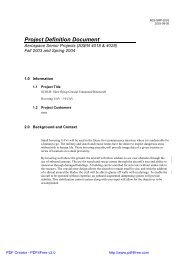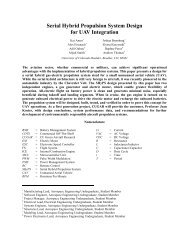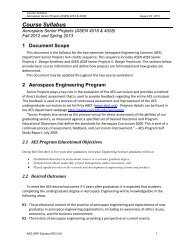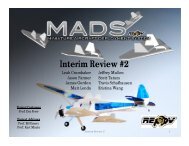PFR - Aerospace Engineering Sciences Senior Design Projects ...
PFR - Aerospace Engineering Sciences Senior Design Projects ...
PFR - Aerospace Engineering Sciences Senior Design Projects ...
You also want an ePaper? Increase the reach of your titles
YUMPU automatically turns print PDFs into web optimized ePapers that Google loves.
Project Final Report – CUDBF April 30 th , 2009<br />
ASEN 4028: <strong>Aerospace</strong> <strong>Senior</strong> <strong>Projects</strong><br />
the release trigger directly behind the spring. This screw was then tied to a servo, and when<br />
pulled, activated the mechanism and released any stores that were attached to it.<br />
The centerline mount was built from a large sheet of plywood. Once cut, the plywood sheet was<br />
sanded smooth on all sides. Holes were cut into the mount to hold two release mechanisms and<br />
the servo in between which controlled both mechanisms. Great care was taken to ensure that the<br />
servo arm lay in the same plane as the release mechanism’s tops, so small balsa blocks were<br />
sized to raise the servo up to the necessary height. Making sure that the wiring remains long<br />
enough to thread through the wings, the servo was screwed into the balsa blocks and the release<br />
mechanisms into the plywood mount. The servo arm was then tied to each release system and<br />
the centerline mount tested with the centerline store.<br />
12.2 Exterior Sub-Assembly<br />
Figure 107: Exterior Vertical and Main Gear Assembly<br />
The aircraft verticals were built by first removing the rudders using a bandsaw and carefully<br />
measuring the exact locations where the rudder is located. Once removed, the vertical and<br />
rudder were sheeted with balsa wood attached with Gorilla Glue © . When the glue set, the pieces<br />
were removed from their molds and any excess balsa removed. The verticals and rudders were<br />
then sanded to remove excess glue. At this point, the verticals were shaped to be easily fitted to<br />
the wingtip of the aircraft. Thus an airfoil hollow which stops halfway through the vertical was<br />
cut into the bottom of the vertical. This allowed the vertical to sit atop the wingtip snugly.<br />
Small balsa blocks were attached to the tops of the two pieces and sanded to a curved shape to<br />
improve aircraft aerodynamics. A cavity was created in the verticals to hold an interior-mounted<br />
servo which controls the rudder, and at the same time the rudders were monokoted. Holes were<br />
drilled into the rudder and small hinges glued into the holes, with like holes being drilled into the<br />
vertical. The vertical was then itself monokoted and the exposed rudder hinges glued into the<br />
vertical taking care not to cover the hinge with excess glue, which impinged on rudder<br />
movement. The servo was then attached to the rudder and the system tested.<br />
125
















